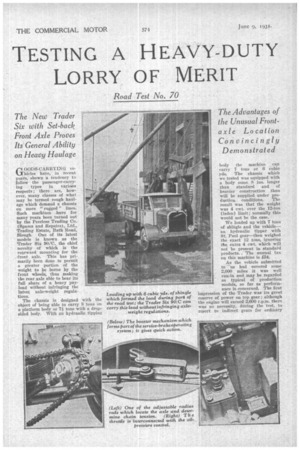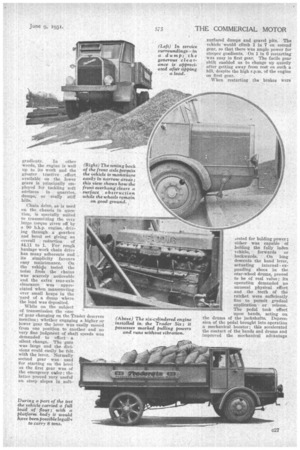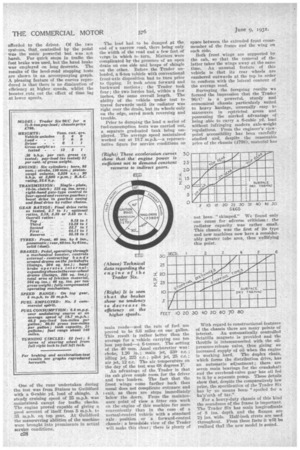TESTING A HEAVY-DUTY LORRY OF MERIT
Page 48

Page 49

Page 50

If you've noticed an error in this article please click here to report it so we can fix it.
The New Trader Six with Set-back Front Axle Proves Its General Ability on Heavy Haulage
r1OODS-CARRYING have, in recent years, shown a tendency to follow the passenger-carrying types in various respects ; there are, however, many classes of what may be termed rough haulage which demand a chassis on more " rugged " lines. Such machines have for many years been turned out by the Peerless Trading Co. (Spares and Repairs), Ltd., Trading Estate, Bath Road, Slough. One of its latest models is known as the Trader Six 90/0, the chief novelty of which is the rearward mounting for the front axle. This has primarily been done to permit a greater portion of the weight to be borne by the front wheels, thus making the rear axle able to bear its full share of a heavy payload without infringing the latest axk-weight regulations.
The chassis is designed with the object of being able to carry 8 tons on a platform body or 74 tons with a dropsided body. With an hydraulic tipping body the machine can carry 7 tons or 6 Cubic yds. The chassis which we tested was equipped with a body some, 8 ins, longer than standard and of heavier construction than will be supplied under production conditions. The. result was that the weight was 4 cwt. over the 12-ton (laden) limit ;.normally this would not be the case. .
We loaded up with 7 tans of shingle and the vehicle— an hydraulic tipper with St. Paul gear—then weighed the exact 12 tons, ignoring the extra 4 cwt. which will not be present in standard products.. The annual tax on this machine is .f54.
As the vehicle submitted to —us had covered some 2,000 miles it was well run-in and may be regarded as typical of production
models, so far as performance is concerned. The first impression of the Trader was its great reserve of power on top gear ; although the engine will exceed 2,600 r.p.na. there was no necessity, during the test, to resort to indirect gears for ordinary gradients. In other words, the engine is well lip to its work and the greater tractive effort. available on the lower gears is principally employed for tackling soft surfaces in quarries, dumps, or really stiff hills.
Chain drive, as is used on the chassis in question, is specially -suited to transmitting the very large torque given off by a 90 b.h.p. engine, driving through a gearbox and bevel set giving an overall reduction of 44.11 to 1. For rough haulage work chain drive has many adherents and its simplicity favours easy maintenance. On the vehicle tested the noise from the chains was scarcely noticeable and the extra rear4txle clearance was appreciated when mameuvring over small heaps in the yard of a dump where the load was deposited.
While on the subject of transmission the ease of gear changing en the Trader deserves mention; whether engaging a higher or lower gear the lever was easily moved from one position to another and no very fine judgment of shaft speeds Was demanded to effect. a silent change. The gate was large and the divisions could easily be felt. with the lever. Normally aeeond gear was used for starting on the level as the first gear was of :the emergency cagier; the latter proved very useful CU steep slopes in soft
surfaced dumps and gravel pits. The
• vehicle -would climb 1 in 7 on second gear, so that there was ample power for steeper gradients. On 1 in 6 restarting was easy in first gear. The facile gear shift enabled us to change up quietly after getting away from rest on such a hill, despite the high r.p.m. of the engine on first gear.
When restarting the brakes were Lested for holding power; either was capable of holding the fully laden vehicle, forwards or backwards. On long descents the hand lever, actuating internalexpanding shoes in the rear-wheel drums, proved to be of real value; its operatibn demanded no unusual physical effort and the teeth of the ratchet were sufficiently fine to permit gradual application or release. The pedal took effect upon bands, acting on the drums of the jaekshafts. Depression of the pedal brought into operation a mechanical booster; this accelerated the contact of the bands and drums and improved the mechanical advantage afforded to the driver. Of the two systems, that controlled by the pedal was the more powerful but was not harsh. For quick stops in traffic the foot brake was used, but the hand brake was employed on long descents. The results of the level-road stopping tests are shown in an accompanying graph. A pleasing feature of the curves reproduced is that there is no diminution of efficiency at higher speeds, whilst the booster cuts out the effect of time lag at lower speeds..
One of the runs undertaken during the test was from Staines to Guildford with a 6-cubic yd. load of shingle. A steady cruising speed of 25 m.p.h. was .maintained, except for traffic checks. The engine proved capable of giving a good account of itself from 5 m.p.h. to 35 m.p.h. on top gear. At Guildford the manceuvring abilities of the machine were brought into prominence in actual Service conditions, The load had to be dumped at the.. end of a narrow road, there being only the width of the road and a few feet of verge in which to turn. Matters were complicated by the presence of an open drain on one side and heaps of shingle on the other. Before the Trader unloaded, a 6-ton vehicle with conventional front-axle disposition had to turn prier to tipping. It took seven forward and backward motions; the Trader took four ; the two lorries had, within a few inches, the same overall length. The ability of the vehicle under test to travel forwards until its radiator was right over the drain, but its wheels only on the edge, saved much reversing and trouble.
Prior to dumping the load a series of fuel-consumption tests was carried out, a separate graduated tank being employed. The average speed maintained worked out at 19.7 m.p.h.—a representative figure for service conditions ou main roads—and the rate of fuel use proved to be 6.6 miles on one gallon. This result is rather better than the average for a vehicle carrying one ton less pay-load—a 6-tonner. The setting of the 40 mm. Amal carburetter was: choke, 1.26 in. ; main •jet, 330 cc.; idling jet, 225 c.c.; pilot jet, 25 c.c.; air jet, 12 c.c. The air temperature on the day of the test was 68 degrees F.
An advantage of the Trader is that its cab gives ample room for the driver and two loaders. The fact that the front wings come farther hack than usual does not complicate entrance and i exit, 88 there are steps immediately below the doers. From the maintenance point of view a fitter can work on the engine of this machine far more conveniently than in the ease of a normal-control vehicle with a standard axle position or a forward-control chassis; a broadsisle view of the Trader will make this clear ; there is plenty of space between the extended front crossmember of the frame and the wing on each side.
Both front wings are supported by the cab, so that the removal of the latter takes the wings away at the same time. An unusual feature of this vehicle is that its rear . wheels are cambered outwards at the top in order to conform with the lateral contour of the average road.
Surveying the foregoing results we formed the impression that the Trader 90/0 is a powerful, sturdy and economical chassis particularly suited to heavy haulage, unusually easy to manoluvre in restricted areas and possessing the marked advantage of being able to carry a 6-cubic yd. lead without infringing modern axle-weight regulations. From the engineer's viewpoint accessibility has been carefully studied and, despite the reasonable price of the chassis (£798), material has With regard to constructional features of the chassis there are many points of interest. An automatically controlled Scintilla magneto is provided and the throttle is interconnected with the oilpressure-release valve, thus giving an increased supply of oil when the engine is working hard. The duplex chain, which forms the distribution drive, has an automatic adjustment; there are seven main bearings for the crankshaft and the overhead-valve gear has oil fed to it by a separate pump. These details show that, despite the comparatively low price, the specification of the Trader Six has by no means been* " spoiled for a ha'p'orth of tar."
For a heavy-duty chassis of this kind the soundness of the frame is important. The Trader Six has main long,itudinals of 8 ins, depth and the flanges are 21 ins. wide. Half-inch rivets are used throughout. From these facts it will be 'realized that the new model is sound..












































































































